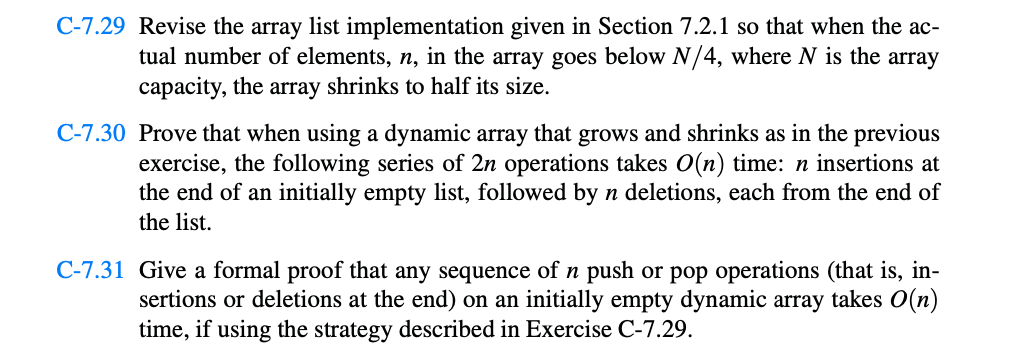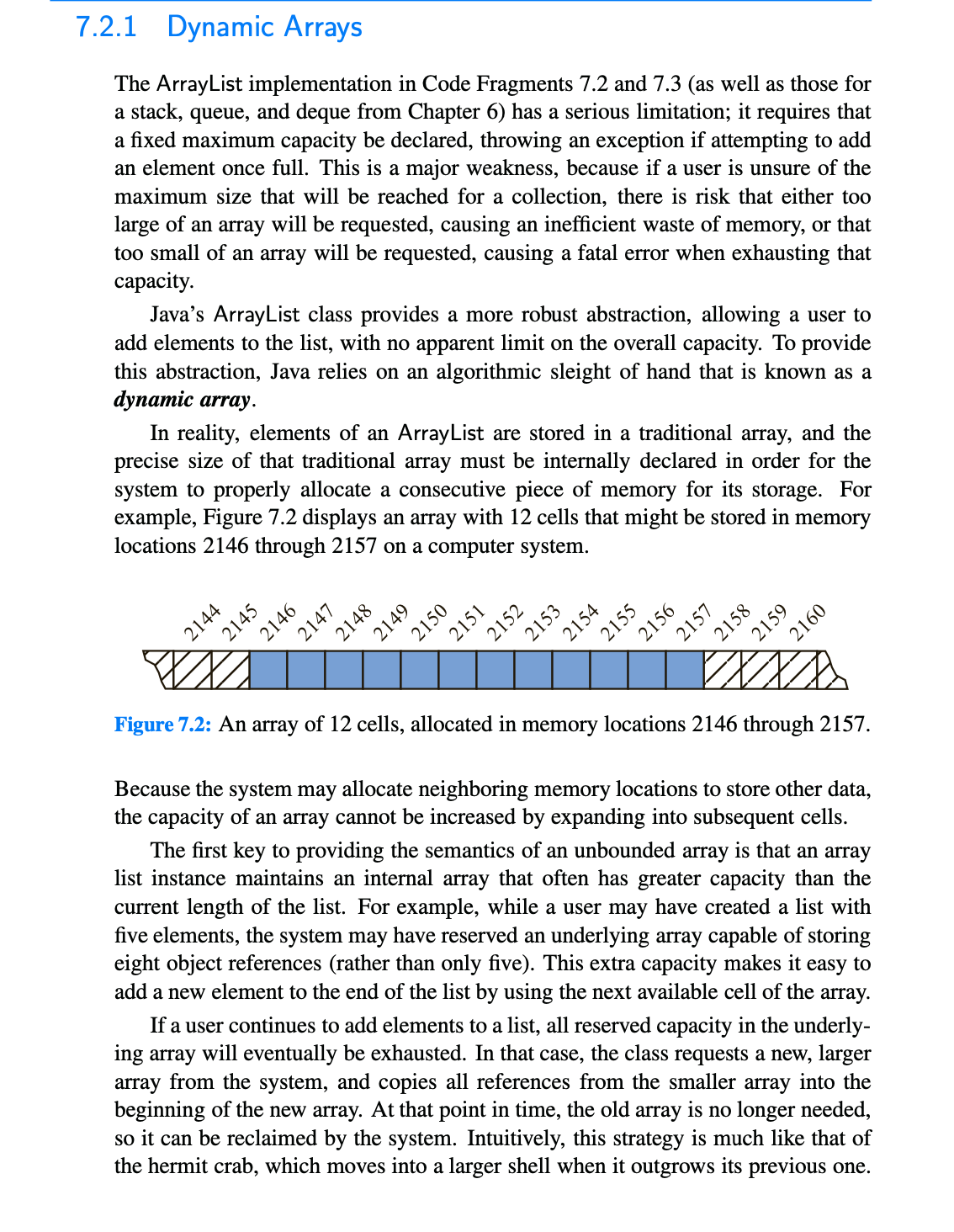C-7.31 Give a formal proof that any sequence of n push or pop operations (that is, in- sertions or deletions at the end) on an initially empty dynamic array takes O(n) time, if using the strategy described in Exercise C-7.29.
C-7.31 Give a formal proof that any sequence of n push or pop operations (that is, in- sertions or deletions at the end) on an initially empty dynamic array takes O(n) time, if using the strategy described in Exercise C-7.29.
Database System Concepts
7th Edition
ISBN:9780078022159
Author:Abraham Silberschatz Professor, Henry F. Korth, S. Sudarshan
Publisher:Abraham Silberschatz Professor, Henry F. Korth, S. Sudarshan
Chapter1: Introduction
Section: Chapter Questions
Problem 1PE
Related questions
Question
Java
Please help me with C 7.31:

Transcribed Image Text:C-7.29 Revise the array list implementation given in Section 7.2.1 so that when the ac-
tual number of elements, n, in the array goes below N/4, where N is the array
capacity, the array shrinks to half its size.
C-7.30 Prove that when using a dynamic array that grows and shrinks as in the previous
exercise, the following series of 2n operations takes O(n) time: n insertions at
the end of an initially empty list, followed by n deletions, each from the end of
the list.
C-7.31 Give a formal proof that any sequence of n push or pop operations (that is, in-
sertions or deletions at the end) on an initially empty dynamic array takes O(n)
time, if using the strategy described in Exercise C-7.29.

Transcribed Image Text:7.2.1 Dynamic Arrays
The ArrayList implementation in Code Fragments 7.2 and 7.3 (as well as those for
a stack, queue, and deque from Chapter 6) has a serious limitation; it requires that
a fixed maximum capacity be declared, throwing an exception if attempting to add
an element once full. This is a major weakness, because if a user is unsure of the
maximum size that will be reached for a collection, there is risk that either too
large of an array will be requested, causing an inefficient waste of memory, or that
too small of an array will be requested, causing a fatal error when exhausting that
capacity.
Java's ArrayList class provides a more robust abstraction, allowing a user to
add elements to the list, with no apparent limit on the overall capacity. To provide
this abstraction, Java relies on an algorithmic sleight of hand that is known as a
dynamic array.
In reality, elements of an ArrayList are stored in a traditional array, and the
precise size of that traditional array must be internally declared in order for the
system to properly allocate a consecutive piece of memory for its storage. For
example, Figure 7.2 displays an array with 12 cells that might be stored in memory
2157 on a computer
locations 2146 through
system.
2144
2145
2146
2147
2148
2149
2150
2151
2152
2153
2154
2155
2156
2157
2158
2159
2160
XX
Figure 7.2: An array of 12 cells, allocated in memory locations 2146 through 2157.
Because the system may allocate neighboring memory locations to store other data,
the capacity of an array cannot be increased by expanding into subsequent cells.
The first key to providing the semantics of an unbounded array is that an array
list instance maintains an internal array that often has greater capacity than the
current length of the list. For example, while a user may have created a list with
five elements, the system may have reserved an underlying array capable of storing
eight object references (rather than only five). This extra capacity makes it easy to
add a new element to the end of the list by using the next available cell of the array.
If a user continues to add elements to a list, all reserved capacity in the underly-
ing array will eventually be exhausted. In that case, the class requests a new, larger
array from the system, and cop all references from the smaller array into the
beginning of the new array. At that point in time, the old array is no longer needed,
so it can be reclaimed by the system. Intuitively, this strategy is much like that of
the hermit crab, which moves into a larger shell when it outgrows its previous one.
Expert Solution
This question has been solved!
Explore an expertly crafted, step-by-step solution for a thorough understanding of key concepts.
This is a popular solution!
Trending now
This is a popular solution!
Step by step
Solved in 3 steps with 1 images

Knowledge Booster
Learn more about
Need a deep-dive on the concept behind this application? Look no further. Learn more about this topic, computer-science and related others by exploring similar questions and additional content below.Recommended textbooks for you

Database System Concepts
Computer Science
ISBN:
9780078022159
Author:
Abraham Silberschatz Professor, Henry F. Korth, S. Sudarshan
Publisher:
McGraw-Hill Education

Starting Out with Python (4th Edition)
Computer Science
ISBN:
9780134444321
Author:
Tony Gaddis
Publisher:
PEARSON

Digital Fundamentals (11th Edition)
Computer Science
ISBN:
9780132737968
Author:
Thomas L. Floyd
Publisher:
PEARSON

Database System Concepts
Computer Science
ISBN:
9780078022159
Author:
Abraham Silberschatz Professor, Henry F. Korth, S. Sudarshan
Publisher:
McGraw-Hill Education

Starting Out with Python (4th Edition)
Computer Science
ISBN:
9780134444321
Author:
Tony Gaddis
Publisher:
PEARSON

Digital Fundamentals (11th Edition)
Computer Science
ISBN:
9780132737968
Author:
Thomas L. Floyd
Publisher:
PEARSON

C How to Program (8th Edition)
Computer Science
ISBN:
9780133976892
Author:
Paul J. Deitel, Harvey Deitel
Publisher:
PEARSON

Database Systems: Design, Implementation, & Manag…
Computer Science
ISBN:
9781337627900
Author:
Carlos Coronel, Steven Morris
Publisher:
Cengage Learning

Programmable Logic Controllers
Computer Science
ISBN:
9780073373843
Author:
Frank D. Petruzella
Publisher:
McGraw-Hill Education